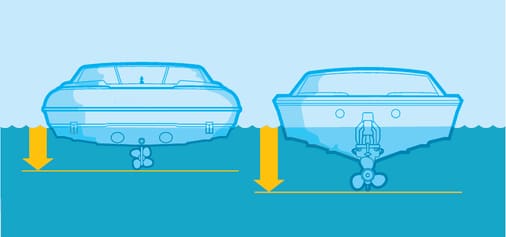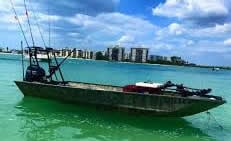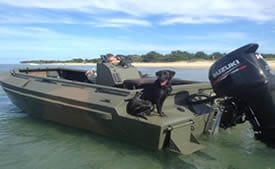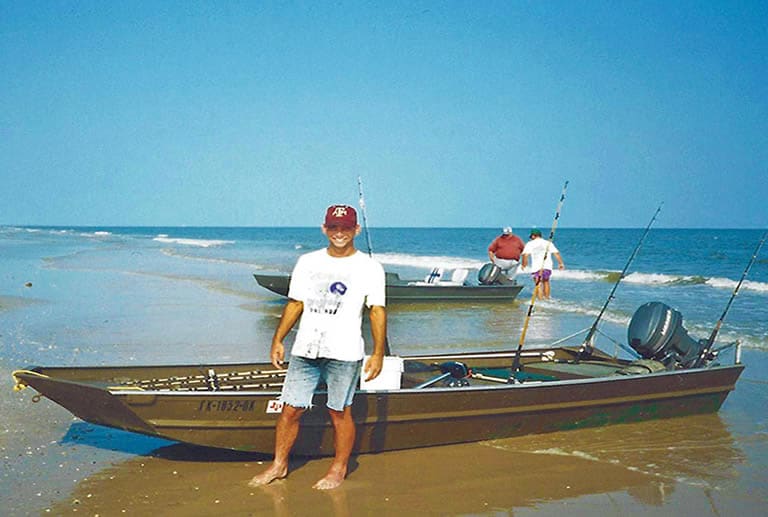Contents
- Can A Jon Boat Go In The Ocean?
- Known Jon Boat Stability Issues In The Ocean & How To Address Them
- Increasing ocean stability is possible (to an extent) via boat modifications
- Adding flotation devices to a Jon boat to make it safer for ocean use
- Creating a saltwater Jon Boat – rigging a Jon boat for saltwater use
- How safe Are Jon boats in the ocean?
- Adding foam as a safety precaution & to make retrieving a sunk boat easier
- Recap: So, Can You Take A Jon Boat In The Ocean?
Can A Jon Boat Go In The Ocean?
Jon boats are among the most popular water vessel in the US. If you own one and live near the coast line then you may be tempted to venture out into open waters in your little flat bottom boat. But, can you take a Jon boat in the ocean safely or is it too dangerous?
You can take a Jon boat in the ocean but only under very specific conditions. A mod-v Jon boat is the best choice for ocean use but only in optimal calm weather conditions and never far from shore.
The flat bottom and low freeboard of a Jon boat make its unsuitable for rough ocean water use.
Using a Jon boat offshore in the ocean is possible but when you follow the rules
The unique design of a Jon boat makes it an ideal utility boat for use on inland bodies of water. Its flat bottom hull allows the boat to traverse extremely shallow waterways giving it the capability of accessing water areas that are simply too shallow for boats with other types of hull, such as a v-hull or even semi-v-hull.
However although the Jon boat’s capacity to navigate very shallow waterways gives it a distinct advantage over other boats when used in rivers and inland bodies of water this very flat bottom design works against it in less than ideal weather conditions and makes it much less suitable to ocean use.
Although many people do use a Jon boat in the ocean the majority of boat enthusiasts strongly argue against doing so for a variety of reasons which we shall go into in this article.
If you do intend to use a Jon boat in the ocean then you should follow the guidelines below.
- Prepare your Jon boat with foam insulation. This will mean the boat will float, at a point just below the waterline, should it take on water and sink.
- Never stray too far from shore, so you can retreat if it gets windy or the weather starts to turn bad.
- Only ever use a Jon boat on the ocean when the weather conditions are favorable.
To use a Jon boat in the ocean, calm waters with very little wave activity are needed, which means limited to no wind.
Let’s look at why a Jon boat is not the best choice for ocean use.
V-shaped hull vs flat bottom Jon boat – safety issues in the ocean
A Jon boat has a flat bottom which allows the vessel to traverse extremely flat waters. We outlined why this design is so efficient for inland waterways in this article.
Traditional v-hull boats are designed to give the boat a high level of stability even in challenging waters. With a flat bottom a Jon boat is much less stable in these conditions.
As a flat bottom boat has stability issues in choppy water many Jon boat owners are curious as to whether it is safe to use a Jon boat offshore in open ocean.
This is a real concern as even with fresh water use, on inland lakes or rivers, a Jon boat can become unstable when the weather turns bad or the wind picks up to create choppy waves.
The flat bottom design that gives a Jon boat its advantage in shallow calm waters can become a problem in the ocean. This is because the boat has very little “wobble room” when it tilts and leans, unlike a v-hull or semi-v.

The low freeboard of a Jon boat also means the side of the boat sit very close to the waterline. Any turbulent water will naturally wash onto the deck.
The problem with a flat bottom boat in rough ocean water
Flat bottom boats were not designed to be used in rough waters. They are designed for rivers, lakes and other inland waterways that are mostly calm and that have large areas of very shallow water.
Ocean waters are a lot less stable and calm than inland waters. Inland waterways are also less prone to sudden changes in conditions.
The hull of a flat bottom boat, and the squared off bow in the case of a Jon boat, makes them unstable in choppy waters and downright dangerous in extremely bad weather.
V-shaped hulls are much better than flat bottom hulls for ocean use for a variety of very good reasons.
A Jon boat’s sides naturally sit very close to the waterline making it easier to take on water in adverse conditions.
If ocean boating is something you really want to try then adding a v-shape to a flat bottom hull is possible. However, this is a time intensive task and not really an easy one as you can see from the interactions of these Jon boat owners.
It is much better to simply use a v-hull boat or limit your ocean excursions to very mild weather.
If you need to understand how a Jon boat reacts in rough water read our article that outlines everything you need to know about Jon boats and rough water.
The dangers of using a Jon boat in rough ocean water
It is not just the hull of a Jon boat that makes it unsuitable for use in rough waters.
Most ocean going vessels will have a bow that is shaped to cut through waves. These bows come in a variety of shapes from the straight bow to the reverse sheer bow and the high cain spoon bow, as shown below.

The above bow types are excellent at slicing through waves. They push the water to either side of the boat creating what is called a “bow wave”. A Jon boat bow has a completely different design that is much less suitable for dealing with waves because it cannot do this..
The typical shape of bow types associated with a Jon boat are square and thus not best suited to moving through waves.
Instead of cutting through waves, the waves will just splash up over the square hull and fill the boat with water especially at speed.
When powered by an outboard motor in calm waters, the bow of a Jon boat will tend to lift slightly out of the water. Its curved raised bow will then protect the boat from taking on water because the water is well below the top of the bow.
However, this design will not protect the boat from taking on water when there are waves to contend with as the water will splash over the top of the bow and into the boat.

For more detailed information about using a Jon boat in rough water read our article Can a Jon Boat Handle Rough Water.
Known Jon Boat Stability Issues In The Ocean & How To Address Them
There are a growing number of Jon boat owners who take action to stabilize their boats even when they have no intentions of using it in the ocean or even in salt water. We demonstrated how to do this in the article how to make a Jon boat more stable.
One way to make a Jon boat more stable is to modify the actual boat design.
Increasing ocean stability is possible (to an extent) via boat modifications
A Jon boat is one of the most friendly type of vessels for customization. Customizing a Jon boat is not just about adding fishing accessories, camouflaging the boat or even converting it into a bass boat.
You can customize a Jon boat to make it much more stable in challenging water conditions.
By widening the boat you can make it a lot more stable but this requires splitting the boat in two and adding extra ribbing and new floor sheets to the bottom of the boat.
You will also need to either modify or completely replace both the prow and the transom.
There’s a video showing how to do this on a 7 ft flat-bottomed 74 smoker craft boat here.
An alternative modification for increasing stability on a Jon boat is to add a v-shape or semi-v shape to the hull. This is not an easy task and may be more hassle than it is worth.
Adding flotation devices to a Jon boat to make it safer for ocean use
An easier way to increase the stability of a Jon boat is to add flotation devices to the outside.
Flotation pods can be attached the rear of the boat for extra buoyancy though these are mostly used for combating the effect of a stern-heavy vessel. The engine, fuel and other necessary items located at the aft of the vessel can make the boat sit lower in the water at the stern.
 Flotation pods help lift the stern higher above the waterline. They do also give the boat a certain amount of additional stability though not a lot.
Flotation pods help lift the stern higher above the waterline. They do also give the boat a certain amount of additional stability though not a lot.
The best type of flotation devices to add to a Jon boat, to make it more stable in the water, are PVC tubes.
By adding two PVC tubes with capped ends to the sides of your boat you can not only stabilize it but also make it much more buoyant while raising the entire higher boat higher above the waterline.
But stability issues aren’t the only problem you will encounter if you take your Jon boat in the ocean.
Creating a saltwater Jon Boat – rigging a Jon boat for saltwater use
Standard Jon boats are fine to use in inland bodies of water (including saltwater lakes) – again, provided the weather conditions are right.
No stability modifications are needed to the boat though you can make those already suggested above. However, most Jon boats are made from aluminum.
Aluminum and saltwater don’t mix!
When saltwater comes into contact with the aluminum hull of your Jon boat galvanic corrosion occurs.
You may not want to use an aluminum Jon boat in the ocean because of the corrosion that takes place on the boat. c
Aluminum corrodes very quickly in saltwater.
There are steps you can take to protect your boat from galvanic corrosion. We outlined those steps in the article can you use a Jon boat in saltwater. If you are intent on taking your aluminum Jon boat in the ocean then you should read that article and implement its advice.
However, a fiberglass, or wooden Jon boat, would be much better choice to take in the ocean.
How safe Are Jon boats in the ocean?
When used correctly in the correct environment Jon boats are very safe.
As far as taking a Jon boat in ocean saltwater goes, you should follow the strict guidelines outlined in this article to stay safe so you can live to boat another day.
Jon boats have been used in America from almost the same time as the “discovery” of the continent. They helped build this nation – ir at least they helped the early pioneers to explore it.
As freshwater utility vessels they are still invaluable today. They are cheap, lightweight and very versatile.
For shallow water navigation flat bottom boats like the Jon boat, are unequaled and when it comes to fishing or hunting on inland waters, a Jon boat is king.
However, Jon boats have some well known stability issues.
Having said that these stability issues only really become a problem when a Jon boat is used in an environment and under conditions that it was never designed to be used in. Such as in challenging weather conditions or in very rough deep open waters.
 When used in unsuitable conditions a Jon boat can become very unstable and even sink.
When used in unsuitable conditions a Jon boat can become very unstable and even sink.
As outlined throughout this article it can be dangerous to take a Jon boat in the ocean and so you should take some precautionary steps to help improve your safety if you intend to use your boat this way.
As well as adding flotation devices you can also take preventative measures to ensure the boat remains buoyant even if it takes on water and sinks.
Adding foam as a safety precaution & to make retrieving a sunk boat easier
You can modify a Jon boat to ensure that it floats close to the top of the water even when the it sinks.
If the boat can stay buoyant just below the water’s surface when it sinks this will give you a change to react to the situation better from a safety point of view. Being able to hold onto the boat can help keep you afloat until help arrives.
It will also allow you to recover expensive equipment that may be otherwise lost to deep waters if the boat sank to the bottom.
You can modify the boat so it does this by adding a layer of foam to the deck.
Contrary to popular opinion adding foam to the interior of your boat does not make the boat more buoyant while it is in use on top of the water.
However, as we outlined here it is still a good idea to add foam to the interior of your boat but for a very different reason.
We recommend you set down a layer of foam underneath the decking as this will stop the boat from completely sinking to the bottom of the river or lake or ocean should it take on too much water and begin to sink.
An interior foam layer will not make the boat buoyant while it is in use but it will make it buoyant enough so that when it gets submerged under water it will float near the waterline and totally sink.
Taking this preventive step is highly recommended if you intend to take a Jon boat in the ocean – for obvious reasons.
Additional steps will also be needed before you take your Jon boat in open saltwater ocean environments.
Recap: So, Can You Take A Jon Boat In The Ocean?
The short answer is: Yes you can take a Jon boat in the ocean. However it comes with some very important caveats!
You can take your Jon boat on the ocean as long as the conditions are right. You need calm water and low wind.
You should never attempt to use a Jon boat in the ocean in bad weather, windy conditions and/or choppy water, or when the forecast predicts any of these.
When using a Jon boat in the ocean never stray too far from shore so you have enough time to retreat should the weather turn unexpectedly.
 Before you go on the ocean be sure to prepare your boat by adding a foam interior below the decking as outlined here.
Before you go on the ocean be sure to prepare your boat by adding a foam interior below the decking as outlined here.
Adding foam will give the boat extra buoyancy if it takes on water and starts to sink. It will then sit just below the waterline allowing you and your crew time to take safety measures and give you something to hold onto until help arrives. It also means you will be able to retrieve your onboard equipment.
You will also need to get some boat navigation lights that attach to both the bow and the stern. You can get ones that are easily fitted and removed, like these ones. You’ll need these for navigating and as a warning to other boats should you be out at night or returning to shore at dusk.
If you have a storage unit, like the one we showed you how to build here, you should also keep a spotlight on your boat.

